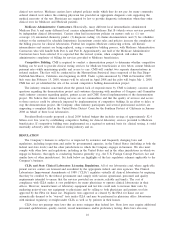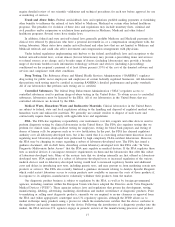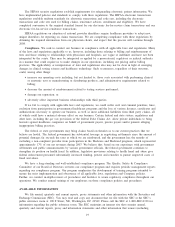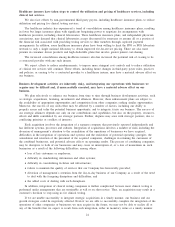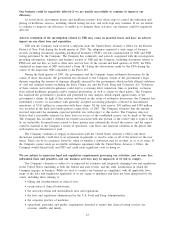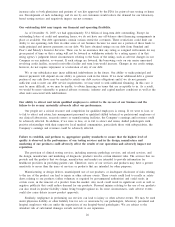Quest Diagnostics 2007 Annual Report Download - page 30
Download and view the complete annual report
Please find page 30 of the 2007 Quest Diagnostics annual report below. You can navigate through the pages in the report by either clicking on the pages listed below, or by using the keyword search tool below to find specific information within the annual report.
Item 1A. Risk Factors
You should carefully consider all of the information set forth in this Report, including the following risk
factors, before deciding to invest in any of our securities. The risks below are not the only ones that we face.
Additional risks not presently known to us, or that we presently deem immaterial, may also negatively impact us.
Our business, financial condition, results of operations or cash flows could be materially impacted by any of
these factors.
This Report also includes forward-looking statements that involve risks or uncertainties. Our results could
differ materially from those anticipated in these forward-looking statements as a result of certain factors,
including the risks we face described below and elsewhere. See “Cautionary Factors that May Affect Future
Results” on page 29.
The clinical testing business is highly competitive, and if we fail to provide an appropriately priced level of
service or otherwise fail to compete effectively it could have a material adverse effect on our net revenues
and profitability.
While there has been significant consolidation in recent years in the clinical testing business, it remains a
fragmented and highly competitive industry.
We primarily compete with three types of clinical test providers: hospital-affiliated laboratories, other
independent clinical laboratories and physician-office laboratories. We also compete with anatomic pathology
practices and large physician group practices. Hospitals generally maintain on-site laboratories to perform testing
on their patients (inpatient or outpatient). In addition, many hospitals compete with independent clinical
laboratories for outreach (non-hospital patients) testing. Most physicians have admitting privileges or other
relationships with hospitals as part of their medical practice and hospitals may seek to leverage their relationships
with community physicians and encourage the physicians to send their outreach testing to the hospital’s
laboratory. In addition, hospitals that own physician practices generally require the physicians to refer tests to the
hospital’s laboratory. As a result of this affiliation between hospitals and community physicians, we compete
against hospital-affiliated laboratories primarily based on quality of service. Our failure to provide a broad test
menu or service superior to hospital-affiliated laboratories and other laboratories could have a material adverse
effect on our business.
If we fail to compete effectively, our business could be adversely affected and our net revenues and
profitability could be damaged.
Government payers, such as Medicare and Medicaid, have taken steps to control the utilization and pricing
of healthcare services, including clinical test services.
We face efforts by government payers to reduce utilization and pricing for clinical testing services.
From time to time, Congress has legislated reductions in, or frozen updates to, the Medicare Clinical
Laboratory Fee Schedule. In addition, CMS has adopted policies limiting or excluding coverage for clinical tests
that we perform. We also are subject to Congressional mandates, such as a mandate for Medicare to conduct a
demonstration project to determine whether competitive bidding for clinical test services can reduce costs without
adversely impacting quality and beneficiary access to services. We also provide physician services which are
reimbursed by Medicare under a physician fee schedule, which is subject to adjustment on an annual basis. CMS
changes add to our costs by increasing complexity and administrative requirements. Medicaid reimbursement
varies by state and is subject to administrative and billing requirements and budget pressures.
In addition, over the last several years, the federal government has sponsored programs to expand private
health insurance programs for Medicare beneficiaries, called “Medicare Advantage” programs, and has encouraged
such beneficiaries to switch from the traditional programs to the private programs. There has been rapid growth
of health insurance plans offering Medicare Advantage programs, and of beneficiary enrollment in these
programs. Also in recent years, states have increasingly mandated that Medicaid beneficiaries enroll in private
managed care arrangements. If these efforts continue to be successful, we may experience a further shift of
traditional Medicare and Medicaid beneficiaries to private health insurance options.
We expect efforts to reduce reimbursements, to impose more stringent cost controls and to reduce utilization
of clinical test services will continue. These efforts, including changes in law or regulations, may have a material
adverse impact on our business.
21







